A New Era for PCs
Picture a world where your laptop doesn’t run Windows or macOS but a homegrown system that syncs seamlessly with your phone and tablet. On May 8, 2025, Huawei unveiled its first HarmonyOS 5-powered PC, the MateBook Pro, at the HarmonyOS Computer Technology and Ecosystem Communication Event in Shenzhen, China. This launch, set for May 19, marks a defiant step for Huawei, challenging the dominance of Microsoft and Apple in the PC market.
The announcement sparked buzz on X, with users like@thinking_panda praising HarmonyOS 5’s custom microkernel, built from scratch to rival Western systems. “It’s like Huawei just opened a new highway in a traffic-jammed city,” says Zhu Dongdong, Huawei’s President of Tablets and PCs. But what powers this ambitious operating system, and can it really compete?
The Engine Under the Hood
Imagine you’re a chef crafting a dish without relying on pre-packaged ingredients. HarmonyOS 5 is Huawei’s recipe, built on three pillars: HarmonyOS Base, Ecosystem, and Experience. The Base uses a proprietary microkernel and the Ark Engine for smooth graphics, while StarShield architecture ensures robust security, akin to a digital fortress protecting your data.
The system integrates AI through Celia, an assistant that summarizes documents or translates on the fly, much like a personal librarian. According to a 2025 TechCrunch report, Huawei’s shift to HarmonyOS 5 follows the expiration of its Windows license in March 2025, pushing the company to innovate independently. To explore Celia’s features, try connecting a Huawei phone to the MateBook Pro for seamless file sharing across devices.
Critics note that HarmonyOS 5’s ecosystem, with over 150 optimized PC apps and 2,000 universal apps, is still growing. “It’s a bold move, but Windows’ app library is a skyscraper compared to Huawei’s cottage,” says an analyst quoted in Xinhua. Yet, Huawei’s focus on cross-device connectivity—like syncing your phone’s RedNote app to your PC—sets it apart.
From Desk to Daily Life
Let’s say you’re a graphic designer in Shanghai. You boot up the MateBook Pro, and its minimalist interface, with a sleek Dock for apps like Gallery and Notes, feels like a decluttered desk. The system’s AI can enhance your workflow: dictate a project brief, and Celia organizes it into a presentation, saving you hours.
To get started, visit Huawei’s App Store on a HarmonyOS device and download WPS, China’s answer to Microsoft Office. A 2025 South China Morning Post article highlights that HarmonyOS 5 supports local software like DingTalk and Bilibili, catering to both work and entertainment. However, some X users warn that global apps like Adobe Creative Suite may not yet be fully compatible, so check app availability before switching.
Huawei’s Kirin X90 processor powers the MateBook Pro, offering performance rivaling Apple’s M3 chip. “It’s like swapping a gas engine for an electric one—smooth and efficient,” says a Weibo tipster quoted by Huawei Central. The laptop’s 140W charging and greyish-blue design add flair, but its real strength is ecosystem integration, letting you mirror your phone’s screen with a tap.
A Market Shake-Up?
HarmonyOS 5’s launch is more than a tech flex; it’s a strategic pivot. With U.S. sanctions cutting Huawei off from Android and Windows, the company has doubled down on self-reliance. A 2025 Digitimes report notes that Huawei began developing HarmonyOS in 2012, with version 5 fully severing Android ties by 2024. This PC launch positions Huawei to capture China’s market, where its smartphones already outpace Apple’s 17% share, per a 2024 Tom’s Hardware analysis.
Yet, challenges loom. “Huawei’s ecosystem is promising, but convincing users to abandon Windows’ vast app library will be tough,” says Richard Yu, Huawei’s Consumer BG Chairman, in a 2025 Reuters post. On X, skeptics like@wmhuo168 argue that HarmonyOS could dominate China but struggle globally due to app gaps. Still, with AI PC shipments projected to hit 40% of global markets by 2025, per Canalys, Huawei’s timing is sharp.
What’s the big picture? Huawei’s push could inspire other firms to develop local OSes, reshaping the global tech landscape. For now, the MateBook Pro offers a glimpse of a future where your PC, phone, and smartwatch hum in perfect harmony.

